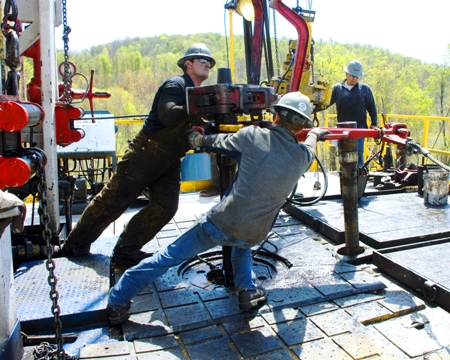|
5/7 – Natural Gas Prices Climb 18% in One Year Wednesday, May 7th 2014
 Workers move a section of well casing into place at a natural gas well site near Burlington, Pa. The single most important factor weighed by decision-makers when evaluating a potential efficiency or renewable energy project is the payback period, or how long it will take for the upfront costs of the project to be recouped in energy savings. This calculation, and in-turn, the viability of the project, depend heavily on current energy prices and future price projections. While Pennsylvania (and the nation at-large) has benefited from lower energy costs over the past few years, there is indications that the historically low prices may be rebounding as demand, bolstered by extreme weather events, catches up to a glut in supply, the result of ambitious drilling in the Marcellus Shale region and other plays throughout North America. The silver lining to higher energy prices, particularly for the energy industry, is that higher energy costs leads more homeowners and businesses to scrutinize their bills, conserve more, and perhaps consider an efficiency or renewable generation alternative. Higher energy prices make avoided energy consumption more valuable, reducing payback periods for projects and creating more business in the smart energy industry. Below is an excerpt from an article in the Wall Street Journal, published on May 6th. Natural-gas prices extended their gains Tuesday as hot weather across the U.S. was expected to spur gas-generated electricity demand for air conditioning at a time when producers usually replenish depleted supplies. Natural gas for June delivery was up 5.2 cents, or 1.1%, at $4.74 a million British thermal units on the New York Mercantile Exchange. After a severe U.S. winter that drained natural-gas stockpiles to an 11-year low, the season of rebuilding stocks has gotten off to an anemic start. Analysts say the U.S. hasn’t been producing and storing enough gas for its stockpiles to reach adequate levels in time for the start of the next heating season in the fall, and futures are climbing as a result, with current prices 18% higher than year-ago levels. “People are nervous that we’re going to see some unexpected seasonal demand,” said Gene McGillian, a broker at Tradition Energy. Analysts say the U.S. needs to add as much as 48% more to inventories during this spring and summer than the recent five-year average to sufficiently rebuild stocks. Estimates for Thursday’s weekly inventory report from the U.S. Energy Information Administration put the figure right around the average, at 72 billion cubic feet. Continued demand for gas-fueled heating and air conditioning is preventing producers from rapidly rebuilding supplies. Spring has been short across much of the country, with cold weather extending into April and summer-like temperatures already arriving in heavily populated areas. Forecasts call for temperatures between 80 and 90 degrees Fahrenheit in Washington, D.C. and in the 90s in California this week that could prompt cooling demand, followed by a cold front in the Northeast in the two-week forecast that could drive late-season heating demand. |
News & Updates
Calendar
|